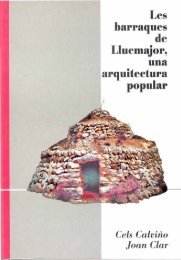La pedra en sec. Materials, eines i tècniques tradicionals a les illes ...
La pedra en sec. Materials, eines i tècniques tradicionals a les illes ...
La pedra en sec. Materials, eines i tècniques tradicionals a les illes ...
You also want an ePaper? Increase the reach of your titles
YUMPU automatically turns print PDFs into web optimized ePapers that Google loves.
*** *<br />
* * *: 5 5.7 THE WORK<br />
height of the facing, stones are laid<br />
besides and lined with the foundations<br />
to level the <strong>sec</strong>tion off up to the<br />
obstacle. The use of a range of arches<br />
or lintels means that the wall can continue<br />
to be built above the projecting<br />
object without risk of the stones sliding<br />
and giving rise to a wall collapse.<br />
The stones in a drystone wall are laid<br />
following the levelling line; wh<strong>en</strong> the<br />
stones are too close to the levelling<br />
line and stick out too much from the<br />
facing, the drystone mason says that it<br />
is 'going strong', whereas in the<br />
opposite case it is said to be 'going<br />
weak'.<br />
As the rows are laid, the back of the<br />
wall is filled with rubble and the levelling<br />
line is raised to mark the next row<br />
of stones. If it is a double facing wall<br />
(as for terrace walls with a <strong>sec</strong>ondary<br />
facing, boundary walls or walls of<br />
huts), the space betwe<strong>en</strong> the two<br />
facings and the area behind the terrace<br />
wall's <strong>sec</strong>ondary facing is filled<br />
with rubble.<br />
Filling the terrace walls with rubble<br />
means that excess water can be pro-<br />
perly drained from the land. The<br />
importance of this point is recognised<br />
by all drystone masons, who highlight<br />
the need to place the rubble carefully<br />
and to make sure that it will not move<br />
in the future.<br />
There is no exact answer as to how<br />
wide the rubble filling should be as<br />
this will dep<strong>en</strong>d on the type of land,<br />
the availability of rubble and in all<br />
cases on the experi<strong>en</strong>ce of the drystone<br />
mason. It is advisable to make the<br />
rubble as thick as possible.<br />
As the wall is being built the best stones<br />
are put to one side to be used to<br />
finish off the wall, to serve as corner<br />
stones, etc.<br />
Most walls in drystone masonry constructions<br />
have a slope or wall base<br />
(terrace walls, hut walls, boundary<br />
walls, etc.) This means they are more<br />
solid since their bases are wider than<br />
their tops. Vertical walls, built on a<br />
plumb line, may be considered to be<br />
an exception and are usually only<br />
used for small terrace walls and for<br />
internal well walls.<br />
Stepped terrace walls, in which the




